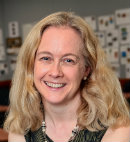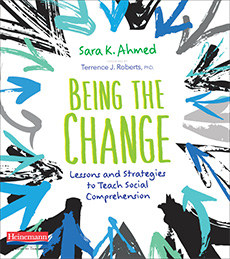Be the Change: Teach Social Comprehension
Being the Change: Lessons and Strategies to Teach Social Comprehension
By Sara K. Ahmed
(Heinemann, 2018 – Learn more)

When I browse the new books shelf at the library, usually I’ll look for titles on history, cooking or biography – such as the brief yet profound Note to Self: Inspiring Words from Inspiring People, with notables such as Frank Gehry, Alice Waters and Maya Angelou writing letters to their younger selves about what they wish they had known.
Recently, though, I found Sara K. Ahmed’s Being the Change on the new books shelf, among mass-appeal books on weight loss, leadership and vegan cooking. Ahmed’s is the only book about pedagogy I’ve seen there – an indicator of how much teaching about social issues seems relevant to the larger culture today.

The book doesn’t explicitly target a specific age group, but many of the examples come from upper elementary students. As a middle school history teacher, I found myself wanting to use many of Ahmed’s strategies with my own students, to deepen our conversations and our relationships with each other.
Just Listen (a.k.a., Stop Talking for a Minute!)
In Ahmed’s introduction, she focuses on being open to trusting students when you walk into the room each day. As someone who discusses difficult issues with eighth graders daily through current events, ranging from immigration to abortion, I appreciated her reminder that we as teachers need to be emotionally prepared and attuned.
To remind us to set aside defensiveness for calm, Ahmed quotes one of the first books I ever loved about teaching, Robert L. Fried’s The Passionate Teacher (2001): “Any of us, when we’re nervous or when things threaten to get out of control, is likely to revert to a more controlling or defensive posture” (xxvi).
I’ve lived this quotation more times than my body wants to remember. Not as much in recent years, but I still know what it feels like to tense up, to feel brittle, to hear the dominating teacher voice come out of my mouth rather than the embracing human one. To rely on power rather than understanding and empathy.
And Ahmed, rather than leaving us in this uncomfortable position, offers approachable ways to address it, all coming back to our students.
First, she says, you need to be ready yourself “to engage in this talk.” Discuss difficult topics with colleagues one-on-one, then in a professional learning community, then in a larger group, “establishing norms for discussion as the number of voices grows” (xxvi).
Next, you need to listen to the students, remembering that by noticing and understanding them, you will be able to teach them far better. I wanted to put on a very quiet, maybe invisible superhero cape after reading this quotation: “Your strongest superpower in the classroom is kid watching. Make it about what the kids are doing and saying. That is, listen; don’t just wait to talk” (xxvii).
In addition, Ahmed urges us to “be ok with silence and discomfort (aka, don’t ‘save’ every moment).”
I tried this difficult strategy just the other day, when we were discussing an issue of alleged police bias toward Latinos on a local freeway, and waited a second or two more than I usually might have before stepping in. Then another student stepped in for me, in a much more organic way than I would have. As Ahmed suggests, we can allow “a student’s emotionally charged words hang in the air without instantly jumping in to smooth things over” (xxvii).
In just the introduction, Ahmed goes on to say so much more that is crucial, such as “decenter your normal” to pull in others’ experiences, imagine how much you truly know about each student, “enter with humility,” and ask plenty of questions to truly comprehend other people’s stories.
Framing Controversial Current Events Through Identity and Action
Several chapters toward the end of the book address how we talk about the news with our students, how they can understand the humanity of others and how they can develop an “action plan” to move from knowledge to impact.
I want to implement Ahmed’s idea of leading up to discussions about current events by asking students to list their own “news,” whether that’s getting a new cat or hearing their parents talk about the impact on their jobs of a new Chinese tariff.
Students start by making a chart, with the first column titled What’s in My News? Then they give commentary on their news through a column titled My Thinking (questions, opinions, ideas, emotions) (82).
Later, as they are ready, they can add two more columns: My Identity, which explains why they in particular care about their news, and My Ideas for Action, which transforms their news into impact.
My Ideas for Action could be as simple as doing research on sites like the “Department of Homeland Security, Pew Research Center, or credible news sources (New York Times, Al Jazeera, and the BBC)” (93). Students can also look at a map, talk with someone inside or outside the room who could be an expert on the topic, or “hunt for the human story” (94).
Practical Tools You Can Use Today
Throughout her book, Ahmed sprinkles ways to “make thinking visible,” drawing on an idea and phrase from Ron Ritchhart’s book of the same name. Seeing familiar thinking routines, such as “At First I Thought… Now I Think,” applied to this material made them come alive in new ways relating to identity.
Ahmed also follows each major section with Addressing Tensions, a list of several ways to troubleshoot each activity. The transparency and experience that went into each of these charts is impressive to witness. Ahmed’s own teacher models and student work help the reader imagine what a lesson sounded or looked like in class.
Be the Change in Your Classroom
Lately I’ve found myself gravitating to teaching books that call our social consciences awake. This book is a quick read that could have lasting impact for so many teachers.
If you flip through the pages and want a place to start, I’d suggest beginning at the opening with Ahmed’s Letter to Readers, a story about bias her father experienced. Then you can either read all the way through, which will give you background in identity charts, microaggressions and more, or consult specific chapters with issues that resonate for you.
Ultimately, Being the Change will ask you to be even more human in the classroom and thus impel your students to share their humanity with you.
I’m in.
Sarah Cooper teaches eighth-grade U.S. history and is dean of studies at Flintridge Preparatory School in La Canada, California, where she has also taught English Language Arts. She is the author of Making History Mine (Stenhouse, 2009) and Creating Citizens: Teaching Civics and Current Events in the History Classroom (Routledge/MiddleWeb, 2017). She presents at conferences and writes for a variety of educational sites. You can find all of Sarah’s writing at sarahjcooper.com.


































